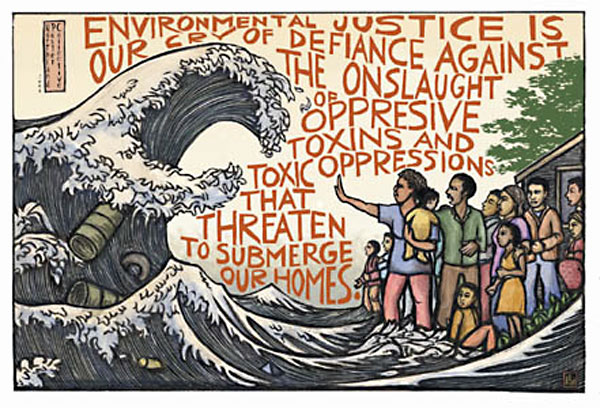The following list of international cases were chosen to illustrate a range of responses that have been used to confront Environmental Racism and promote Environmental Justice around the world.
|
Illustration by: Ricardo Levins Morales |
|---|
Expanding Municipal Services in Bogotá
Location and Context:Bogotá, capital city of the Republic of Colombia. Largest city in the country, population 6,778,691 (2005 Census). Total metropolitan population of 7,881,156.
Problems and Conflicts:Entering the 1990s, the Bogotá faced crumbling infrastructure, high crime rates, and a general lack of services for poorer, outlying neighborhoods. Mobility, long commute times, respiratory infections from pollution, unsafe streets, and access to open spaces were of particular concern.
Issues and Claims:In 1998, newly elected mayor Enrique Peñalosa introduced a transportation and open space program that would improve quality of life and address issues of social justice. Peñalosa created the Transmilenio bus rapid transit system (as of 2007, it runs through the entire city), a Master Plan of Bicycle paths, a Defense of Public Space office, “Pico y Placa” (car restriction program), and one CarFree Day every year. Peñalosa also oversaw huge investments in marginalized neighborhoods, totaling 1.3 trillion pesos (US $800 million). In two years, school participation increased by 30% and the number of violent deaths fell by 42%.
Stakeholders: Enrique Peñalosa: Represented Liberal party in the assembly of Cundinamarca, Bogotá’s province, was economic secretary to Colombia President Virgilio Barco (1986-1990), and was mayor of Bogotá from 1998-2000. He benefited from new legislation that allowed more autonomy for the city’s mayor. Peñalosa is also a possible presidential candidate for the 2010 election.
Voters: Were frustrated going into the 1990s and elected Peñalosa, an alternative candidate, hoping for change.
United Nations Development Program (UNDP): provided funding for the infrastructure programs in Bogotá
Stockholm Challenge: Nominated the Bogotá Project for an award, giving the city’s efforts international recognition for
Links:
The Bogotá Project: http://www.ecoplan.org/voteBogotá2000/vb2_index.htm
Transmilenio (Bus Rapid Transit): http://www.transmilenio.gov.co/transmilenio/home_english.htm
Stockholm Challenge: http://gkp.stockholmchallenge.se/content_scgkp
South Durban Community Environmental Alliance (SDCEA)
Location and Context:Durban, the largest city in the KwaZulu-Natal province in South Africa. Its total population is 3,346,799. South Durban is the city’s industrial basin, and contains over 120 smokestack industries, Durban International Airport, and two heavily polluted canals. Over 280,000 people live in the South Durban townships. Most are ethnic and racial minorities (African, Indian, and other). Apartheid planning has left ethnic and racial minorities in segregated townships and informal settlements on the urban periphery.
Problems and Conflicts: The Engen oil refinery, located adjacent to the Wentworth and Merebank townships, posed a particularly contributes substantial sulfur and carbon oxide emissions, as well as other pollutants. The only environmental leverage against polluting industries is the outdated and lenient Atmospheric Pollution Prevention Act of 1965. When confronted about high pollution levels, Engen insisted it was within legal limits. For this reason, the city and national government were of no help. High rates of leukemia in South Durban (up to 24 times higher than in other parts of South Africa), levels of benzene up to 15 times higher than World Health Organization guidelines, and high rates of respiratory illness among children are among the health concerns.
Issues and Claims:Community activists failed to convince Engen to sign a Good Neighbor Agreement, so they formed South Durban Community Environmental Alliance in order to speak to environmental concerns in their neighborhoods with a single voice. By forming alliances with other receptive industries, they were finally able in 1999 to convince Engen to reduce pollution levels by 65% over five years.
Stakeholders: Engen Refinery: Subsidiary of Engen Limited South Africa, which is owned by a Malaysian National Oil Company, Petroliam Nasional Berhad (Petronas).
SDCEA: Alliance of community groups in South Durban addressing issues of environmental justice. Represents all five communities in South Durban: Merebank, Wentworth, Bluff, Isipingo, and Umlazi.
Links:
SDCEA website (includes map of industries located in South Durban): http://www.h-net.org/~esati/sdcea/
Map of Durban: http://www.umich.edu/~snre492/South%20African%20environmental%20justice%20case%20study_files/image003.gif
Action for Securing Health for All (ASHA)
Location and Context:Delhi, India. Population of over 15 million. One in six persons lives in an informal settlement.
Problems and Conflicts: Informal settlements are characterized by poor and scarce water supply, sanitation, and air, water, and soil pollution. Most often, these settlements are located along drains, near construction sites, and industry, close to busy roads or railroad tracks, and in low-lying areas. Squatters generally suffer from extremely poor health.
Issues and Claims: Public health initiatives for squatters in Delhi have suffered from lack of funding, as well as little understanding or effort from the municipal government. Action for Securing Health for All seeks to address the gap between squatters and government. ASHA facilitated a link between two women’s community groups, the Mahila Mandels and the basti sevikas, with the Slum Wing of Delhi Development Authority, which was looking for new ways to improve services for informal settlements. By filling the need for an intermediary agency between a willing government and the socially isolated squatters who had grown to trust ASHA, this organization used its connections to a variety of sources of funding and other non-profits to create a sustainable health initiative. The initiative serves nearly 115,000 squatters in Delhi.
Stakeholders: Mahila Mandels and the basti sevikas: Women’s self-help community groups in squatter settlements.
ASHA: nonprofit intermediary organization, providing a link between squatters and government, while providing public health expertise and connections to funding sources.
Slum Wing of Delhi Development Authority: Government agency looking for new ways to address public health in slum settlements.
Links:
Mega-Cities Project publication: http://www.megacitiesproject.org/publications_pdf_mcp018h.pdf
Picture of a Delhi Slum: http://www.dka.at/materialien/fotos/projekte/Bilder/Phil-Slum-Kanal_jpg.jpg







